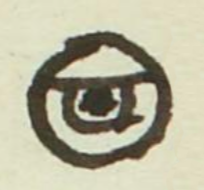Tlamauh (MH573v)
This black-line drawing of the simplex glyph for the personal name Tlamauh (“Wise One" or "Knowing One,” attested here as a man’s name) shows a frontal view of what was originally a starry or stellar eye (doubling as a star in the night sky--see below). This one has the usual circle with concentric half circles and heavy lid, but the added pupil or iris is not part of the earlier hieroglyphs, such as from the Codex Mendoza.
Stephanie Wood
Tlamah (or Tlamao, as it is often spelled) is a powerful name. The style of this eye is also called the starry eye or stellar eye, given how it can double as a star in the sky. This connection with celestial phenomena may relate to the meaning of the personal name. From other examples we also see a connection with Ehecatl. The name seems to derive from tlahmati, supposedly to "practice trickery or sorcery" (very close to tlamati, to know something). However, the translation of sorcery and trickery reveals a Christian bias on the part of the friar Alonso de Molina, and really the Nahuas saw the Tlamao as being wise, perhaps like a priest or a tlamatini. Supporting this, the use of the eye (ixtli) for the glyph calls forth the verb ixtlamati, to be wise, prudent. Furthermore, Marc Thouvenot (2010, 178–181) explains how iximati (which can become imati, to manage cleverly or create skillfully) compares to mati (to know). Imati involves knowing through seeing, much like conocer might indicate in Spanish, and mati is "to know" as in saber in Spanish. Once again, then, the eye glyph is a semantic indicator for a place of wisdom.
The starry eye as found in the Codex Mendoza of c. 1541 gradually evolved--probably through European stylistic influence--to include the eyeball, an iris, and a pupil, all visible below the large eyelid. Eventually, it would also gain eyelashes and an eyebrow and take on a leaf shape (pointed oval), moving away for the perfect circle on the perimeter.
The contextualizing image seems to have a glyph for an occupation (usually found to the right of the name glyph), but it could be an additional part of the name glyph. It has yet to be analyzed.
Stephanie Wood
juā. tlamao
Juan Tlamauh (or Juan Tlamao)
Stephanie Wood
1560
Jeff Haskett-Wood

tlamauh, wise one, knowledgeable person, or possibly sorcerer, https://nahuatl.wired-humanities.org/content/tlamauh
tlamauh(tli), crazed, berzerk, or infected, https://nahuatl.wired-humanities.org/content/tlamauhtli
ix(tli), eye, https://nahuatl.wired-humanities.org/content/ixtli
ixtlamati, to be wise, prudent, https://nahuatl.wired-humanities.org/content/ixtlamati
tlamati, to know something, or to know sacred powers (verb), https://nahuatl.wired-humanities.org/content/tlamati
tlamatini, a sage, wise person, scholar, https://nahuatl.wired-humanities.org/content/tlamatini
tlama, someone knowledgeable, also a medico, https://nahuatl.wired-humanities.org/content/tlama-0
Matrícula de Huexotzinco, folio 573v, https://www.loc.gov/resource/gdcwdl.wdl_15282/?sp=226&st=image
This manuscript is hosted by the Library of Congress and the World Digital Library; used here with the Creative Commons, “Attribution-NonCommercial-ShareAlike 3.0 License” (CC-BY-NC-SAq 3.0).







